Abstract
Grasslands cover more than 25% of the Earth’s surface and play essential ecological roles, such as forage production, supporting pollinators, and carbon sequestration. This study aimed to evaluate the recovery of a degraded pasture of Urochloa decumbens cv. Basilisk through aerial dry mass production, plant height, and foliar macronutrients concentration and uptake after fertilization with polyhalite. The experiment was carried out at the Teaching, Research, and Extension Farm of the School of Agrarian and Technological Sciences, UNESP—Dracena Campus, in a dystrophic red–yellow latosol soil. A randomized block design with four replications was used. The treatments included the following: (T1) control, (T2) N + P + liming, (T3) T2 + 30 kg ha−1 K2O (polyhalite), (T4) T2 + 60 kg ha−1 K2O (polyhalite), (T5) T2 + 60 (30 + 30) kg ha−1 K2O (polyhalite), and (T6) 60 kg ha−1 K2O (polyhalite). The treatment with N + P + liming + 60 kg ha−1 K2O (polyhalite) resulted in 93% more dry mass production when compared with the control treatment. This treatment was most effective for grassland recovery, whereas polyhalite alone was ineffective. Tissue N and S concentrations increased as a result of the addition of N + P + liming + 60 kg ha−1 K2O (polyhalite).
1. Introduction
Grasslands are among the world’s most vital ecosystems, covering more than 25% of the Earth’s surface. They play a key role in forage production, support pollinators, and contribute to carbon sequestration [1]. In 2022, Brazil had more than 177 million hectares of pastures, which is equivalent to 20% of the Brazilian territory [2]. A survey carried out by the MapBiomas institute found that, in 2020, 53% of Brazilian pastures showed some degree of degradation, with 14% being severely degraded [3]. However, increasing pressure from consumers, public institutions, and private stakeholders demands that production systems improve cattle productivity while reducing environmental impacts [4]. Pasture degradation is characterized by a continuous decline in productivity over time and is a common problem throughout Brazil. This process causes agronomic, economic, and environmental losses and is linked to multiple causes, both natural, such as adverse weather, and anthropogenic, such as inadequate management and overgrazing. The consequences of pasture degradation include soil compaction, invasion by undesirable plant species, and a reduction in the carrying capacity of the pasture. Additionally, degradation varies by region and time period, making it difficult to define precise indicators, as the ideal productivity is relative to each specific context [5,6].
Well-managed tropical grassland plays a key role in mitigating climate change through carbon sequestration in soil organic matter. In integrated systems, deep-rooted forage grasses can promote substantial accumulation of belowground biomass, improving soil structure and enhancing long-term carbon storage [7,8]. Practices such as proper fertilization, rotational grazing, and recovery of degraded areas can maximize carbon inputs and reduce greenhouse gas emissions from livestock systems [9]. Thus, grassland rehabilitation using nutrient management strategies not only restores productivity but also contributes to climate mitigation, particularly in tropical regions with high potential for carbon sequestration under improved soil conditions [10,11].
N fertilization is among the most extensively studied agronomic practices due to its widespread application and ability to increase biomass production, primarily by stimulating leaf expansion and tillering. However, excessive N application may accelerate senescence unless it is carefully managed. Additionally, increased N supply often increases the uptake of K, necessitating complementary K fertilization to maintain productivity in N-fertilized systems [12]. The use of N fertilization also contributes to increased plant production and stimulates the proliferation of fungi at the expense of bacteria. However, this increase can be hindered if excessive doses of N are applied [13]. These dynamics underscore the importance of long-term pasture sustainability in balanced nutrient management programs to optimize crop yield and longevity. Balanced nutrient strategies may also mitigate N leaching risks.
K is essential for key physiological processes in plants, including photosynthesis, enzyme activation, protein synthesis, and the regulation of water balance [14]. However, despite its importance, K leaching occurs in diverse soil types, particularly in those with low charge potential, and under the application of highly soluble fertilizers. Soluble K+ ions, derived from fertilizers, soil amendments, or organic matter decomposition, are susceptible to leaching, especially under heavy rainfall or excessive irrigation. The primary factors governing K+ leaching include the soil texture, cation exchange capacity (CEC), water regime, and fertilizer solubility. When present in the soil solution, K+ can migrate with water flow, becoming displaced outside of the root zone [15]. Thus, optimizing K fertilization efficiency requires careful selection of appropriate fertilizer sources to minimize losses and enhance nutrient retention. Strategies such as split applications or precision irrigation could further reduce losses.
Polyhalite is a naturally occurring hydrated sulfate mineral with the chemical formula K2Ca2Mg(SO4)4·2H2O. Its composition is as follows (by percentages): 14% K2O, 48% SO3, 17% CaO, and 6% MgO [16]. Polyhalite contains four essential macronutrients: K, Ca, Mg, and S. Unlike blended fertilizers, polyhalite exists as a homogeneous crystalline compound rather than a mechanical mixture of its constituent elements [17]. This mineral offers several agronomic advantages, including (1) high nutrient solubility and plant availability; (2) multiple commercially available particle size fractions; (3) minimal environmental impact; (4) a comparatively low carbon footprint relative to that of conventional fertilizers; and (5) a lower salt index than similar fertilizers such as potassium chloride (MOP) and potassium sulfate (SOP) although higher than sulfate of potash magnesia (SOPM) [18,19,20]. Furthermore, to ensure a continuous nutrient supply throughout the crop-growing season, polyhalite demonstrates a prolonged nutrient release while reducing environmental losses [21,22].
Grassland degradation is one of the main constraints to livestock productivity in tropical regions, often linked to declining soil fertility, particularly with respect to macronutrients such as K, Ca, magnesium Mg, and S [7,8]. Among the recommended strategies for grassland rehabilitation, the use of correct fertilization plays an important role in reestablishing productivity [23]. In soils with low K availability, doses of 60 kg ha−1 of K2O have been used to restore nutrient balance [24]. Therefore, evaluating the agronomic efficiency of polyhalite in degraded pastures is of both scientific and practical relevance, especially under tropical conditions where nutrient limitations are widespread.
Given the extensive area of degraded pasturelands worldwide, particularly in Brazil, and increasing institutional demands for more efficient natural resource utilization, there is an urgent need to develop sustainable pasture recovery strategies. Considering the vast area of degraded grasslands in Brazil, the use of polyhalite emerges as a particularly attractive restoration strategy, as it provides four of the six essential macronutrients. This may reduce the logistical effort and input costs associated with applying individual fertilizers separately. This study aimed to evaluate the effects of polyhalite fertilization on the nutritional status, growth, and development of forage grass in a degraded dystrophic red–yellow latosol soil. This research seeks to establish optimized polyhalite management practices that can contribute to the technological advancement of sustainable pasture restoration.
2. Materials and Methods
2.1. Experimental Site
The study was conducted between 5 December 2023 and 11 June 2024 at the UNESP Teaching, Research and Extension Farm (Fazenda de Ensino, Pesquisa e Extensão) of the Faculty of Agricultural and Technological Sciences, located at the Dracena Campus in São Paulo State, Brazil (21°27′42.3″ S, 51°33′04.0″ W); the plots were designed as 4 m long by 3 m wide, totaling 12 square meters (Figure 1).
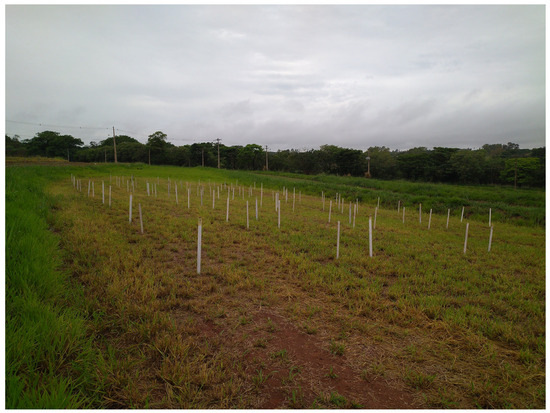
Figure 1.
Experimental site prior to the initiation of the experiment.
2.2. Meteorological Data
The experiment was carried out in a region with an Aw climate, and daily meteorological data were recorded from a weather station located approximately 300 m from the experiment site (Figure 2). Throughout the study period, the cumulative precipitation reached 54% of the historical average for the corresponding timeframe.
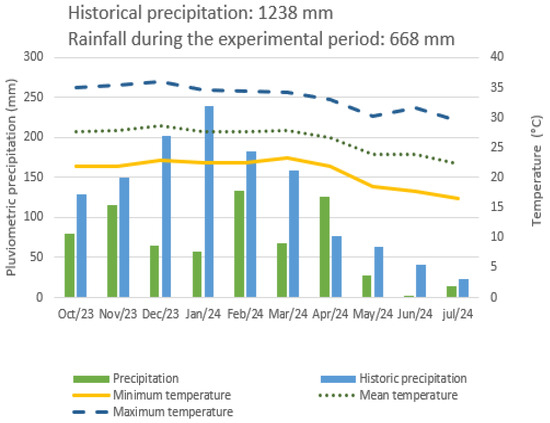
Figure 2.
Average temperatures and precipitation during the 2023–2024 agricultural experiment.
2.3. Treatment and Experimental Design
The experiment employed a completely randomized block design with four replicates and repeated measures across four growth cycles. Liming was necessary to achieve a soil exchange capacity (CEC) of 50%; for this purpose, dolomitic limestone was used. Treatments were applied 35 days after plot liming and consisted of the following:
- T1—Control: No fertilization;
- T2—NP + liming: 75 kg ha−1 N + 60 kg ha−1 P2O5 + liming;
- T3—T2 + 30 kg ha−1 K2O (polyhalite) + liming;
- T4—T2 + 60 kg ha−1 K2O (polyhalite) + liming;
- T5—T2 + split application of (30 + 30) kg ha−1 K2O (polyhalite) + liming;
- T6—K-only: 60 kg ha−1 K2O (polyhalite).
The initial fertilizer application for the experiment occurred on 5 December 2023. In the fertilized plots, the same doses of N and P2O5 were applied: 75 kg ha−1 and 60 kg ha−1, respectively. After the second and third cuts, two more doses of 25 kg ha−1 of N, via urea, were applied in treatments 2, 3, 4, and 5 to reach the specified 75 kg. Phosphorus in the form of monoammonium phosphate was applied only at the beginning of the experiment. The second dose of K2O (30 kg ha−1) via polyhalite in T5 was applied after the second cut of the forage.
The polyhalite product used in this study was POLY4®, a branded granulated polyhalite product of Anglo American crop nutrients, London, England (www.poly4.com) (accessed on 5 September 2025). Throughout the study, the POLY4® treatment is referred to as polyhalite.
2.4. Soil Collection and Analysis
Soil samples were collected from the 0–20 cm depth layer of a red–yellow latosol [25] and analyzed following the methodology described previously by [26], the soil samples were collected from each of the 24 plots, and then a representative average of the experimental area was calculated. Initial chemical characterization revealed the following soil composition properties: 4.3 mg dm−3 Phosphorus (P-resin), 1.7 mmolc dm−3 potassium (K+), 2.3 mg dm−3 sulfur (S), 8.5 mmolc dm−3 calcium (Ca2+), 1.7 mmolc dm−3 magnesium (Mg2+), 1.0 mmolc dm−3 aluminum (Al3+), and 9.6 g dm−3 soil organic matter (SOM); pH (CaCl2) of 4.79; sum of bases (SB), 12 mmolc dm−3; cation exchange capacity (CEC), 33 mmolc dm−3; and base saturation (V%), 36%.
2.5. Sample Harvest
Forage samples were collected by placing a 0.5 m−2 iron quadrat (1 m × 0.5 m) at least 50 cm away from the plot borders. The plants within the quadrat were then cut at a height of 15 cm, collected, and weighed before and after drying. Subsequently, the dried samples were ground in a Willey mill and analyzed according to the methodology described by Malavolta [27]. Macronutrient accumulation was determined as a function of the nutrient concentration and the dry mass production of the aerial part.
2.6. Statistical Analysis
The data were tested for normality (Shapiro–Wilk test) and homoscedasticity (Levene’s test) prior to analysis. The accumulated DM production data were analyzed using ANOVA in a randomized complete block design with a split-plot arrangement. The treatment means were compared using the Scott–Knott test (p < 0.05) [28]. All analyses were performed using Sisvar statistical software version 5.6 [29].
The remaining datasets were analyzed using analysis of variance (ANOVA) in a randomized complete block design, with treatment means compared via the least squares means test at the α = 0.05 significance level [30]. Analyses were performed using SAS statistical software (version 3.81, Enterprise Edition) [31] with the GLIMMIX procedure.
3. Results
ANOVA revealed the significant effects (p < 0.05) of treatments, cutting cycles, and their interaction on the forage DM yield.
First cutting cycle: Treatments 3, 4, and 5 resulted in significantly higher yields than the other treatments did (Table 1), resulting in 56.5, 77.1, and 57.6% higher DM production, respectively, when compared to the control.

Table 1.
Forage DM production of Urochloa decumbens cv. Basilisk as affected by polyhalite application in combination with N and P fertilization.
Second cutting cycle: Treatment 2 resulted in the highest biomass (Table 1) with 55.9% more DM production when compared to the control.
Third cutting cycle: Treatments 4 and 5 outperformed the other treatments (Table 1), producing 139.5 and 136.7% more DM than the control.
Fourth cutting cycle: Treatment 4 resulted in superior performance, with 126.8% greater DM production (p < 0.05) than the N + P + liming control (Table 1).
Compared with all other treatments, the combined application of treatment 4 significantly (p < 0.05) increased forage productivity. Conversely, both the unfertilized control and treatment 6 presented the lowest DM yields (Figure 3).
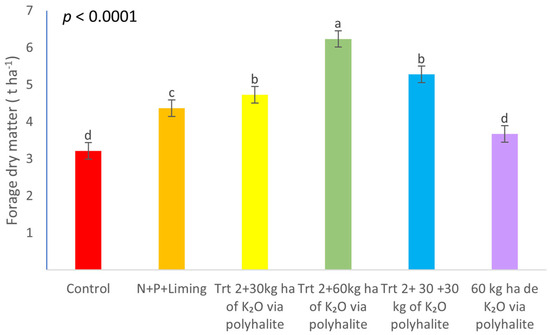
Figure 3.
Accumulated dry matter (DM) yield of Urochloa decumbens cv. Basilisk under different fertilization treatments combining polyhalite with N and P. Values followed by the same lowercase letter do not differ significantly according to the Scott–Knott test at p < 0.05. Overall treatment effect was significant according to ANOVA (p < 0.0001).
3.1. Nutrient Concentration and Uptake
3.1.1. Macronutrient Concentrations
Figure 4 presents the macronutrient concentrations in Urochloa decumbens during the rainy season.
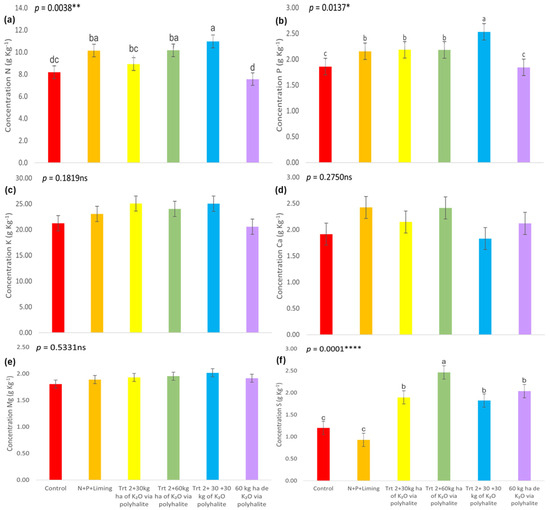
Figure 4.
Macronutrient concentrations in the aerial biomass of Urochloa decumbens cv. Basilisk during the rainy season under different fertilization treatments combining polyhalite with N and P. (a) N, (b) P, (c) K, (d) Ca, (e) Mg, and (f) S. Values followed by different lowercase letters indicate Significance levels: ns (p > 0.05), * (p ≤ 0.05), ** (p ≤ 0.01), **** (p ≤ 0.0001), according to the least squares means test.
During the rainy season, macronutrient concentrations varied significantly. N ranged from 7.57 to 10.98 g kg−1, with the highest concentrations observed in treatment 5 with a concentration yield 34.1% higher than the control. This treatment also showed the highest P concentrations, which ranged from 1.84 to 2.53 g kg−1 which represents 36% higher yields when compared to the control.
The K (20.07–25.07 g kg−1), Ca (1.83–2.43 g kg−1), Mg (1.81–2.02 g kg−1), and S (0.93–2.46 g kg−1) concentrations were also measured. However, there were no significant differences in K, Ca, or Mg concentrations among the different treatments.
Compared with the other treatments, treatment 4 resulted in a significantly greater S concentration (p < 0.05) with a concentration yield of 105.5% higher than the control, whereas both the control and treatment 2 presented the lowest values. Figure 5 presents the ANOVA results for the macronutrient concentrations during the dry season.
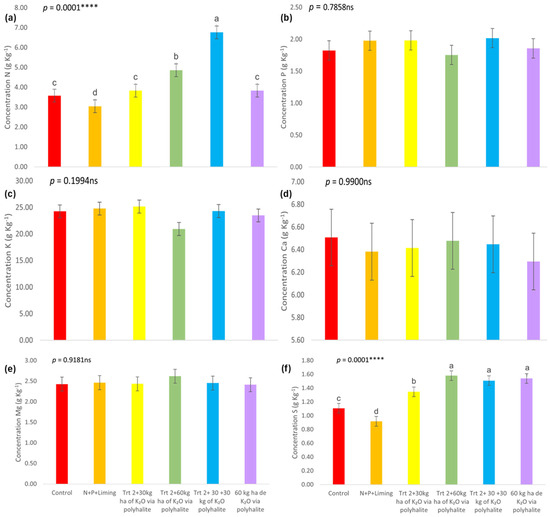
Figure 5.
Macronutrient concentrations in the aerial biomass of Urochloa decumbens cv. Basilisk during the dry season under different fertilization treatments combining polyhalite with N and P. (a) N, (b) P, (c) K, (d) Ca, (e) Mg, and (f) S. Values followed by different lowercase letters indicate significant differences between treatments. Significance levels are denoted as follows: ns (p > 0.05), and **** (p ≤ 0.0001), according to the least squares means test.
The N concentration was significantly greater (p < 0.05) in treatment 5 than in the other treatments; treatment 5 presented 89.1% higher concentration yields than the control. No significant differences (p > 0.05) in P, K, Ca, or Mg concentrations were detected among the treatments. The S concentration was elevated in three treatments: (1) treatment 4, (2) treatment 5, and (3) treatment 6, presenting yields 42.3, 36,0, and 38.7 higher than the control, respectively. While these three treatments showed similar S concentrations (p > 0.05), they all resulted in significantly higher S levels than did the other treatments (p < 0.05).
3.1.2. Macronutrient Uptake
Significant differences (p < 0.05) in macronutrient uptake were observed across all of the treatments during the rainy season (Figure 6).
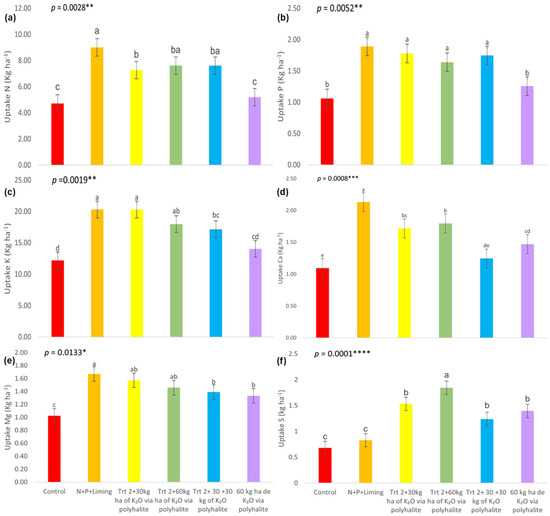
Figure 6.
Macronutrient uptake in the aerial biomass of Urochloa decumbens cv. Basilisk during the rainy season under different fertilization regimes combining polyhalite with N and P: (a) N, (b) P, (c) K, (d) Ca, (e) Mg, and (f) S. Values followed by different lowercase letters indicate significant differences between treatments. Significance levels are denoted as follows: * (p ≤ 0.05), ** (p ≤ 0.01), *** (p ≤ 0.001), and **** (p ≤ 0.0001), according to the least squares means test.
Nitrogen (N): Treatment 2 resulted in the highest N uptake (4.72–9.01 kg ha−1), resulting in 90.9% higher yield when compared to the control, significantly outperforming the other treatments (Figure 6a).
Phosphorus (P): All the completed fertilized treatments (receiving N, P, and K) presented greater P uptake (1.06–1.89 kg ha−1) than the incomplete fertilization regimes did (Figure 6b).
Potassium (K): The treatments 2 and 3 resulted in the highest K uptake (12.20–20.32 kg ha−1) (Figure 6c), where both treatments resulted in 60.6% higher uptake in comparison to the control.
Calcium (Ca) and magnesium (Mg): Treatment 2 yielded maximal uptake of both nutrients (Ca: 5.77–13.12 kg ha−1; Mg: 2.17–5.34 kg ha−1) (Figure 6d,e).
Sulfur (S): Compared with the other treatments, treatment 4 resulted in significantly greater S uptake (0.96–3.21 kg ha−1) (Figure 6f); analysis revealed that treatment 4 had an uptake 170.6% higher than the control.
During the dry season, macronutrient uptake values were recorded within the following ranges: N (3.18−9.73 kg ha−1; Figure 7a), P (2.07−3.56 kg ha−1; Figure 7b), K (21.47−42.54 kg ha−1; Figure 7c), Ca (5.76−13.12 kg ha−1; Figure 7d), Mg (2.17−5.33 kg ha−1; Figure 7e), and S (0.96−3.21 kg ha−1; Figure 7f).
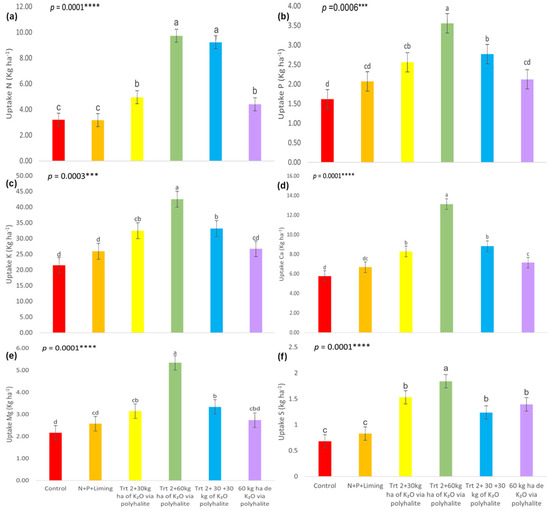
Figure 7.
Macronutrient uptake in the aerial biomass of Urochloa decumbens cv. Basilisk during the dry season under different fertilization treatments combining polyhalite with N and P: (a) N, (b) P, (c) K, (d) Ca, (e) Mg, and (f) S. Values followed by different lowercase letters indicate significant differences between treatments. Significance levels are denoted as follows: *** (p ≤ 0.001), and **** (p ≤ 0.0001), according to the least squares means test.
Compared with that in the other treatments, N uptake was significantly greater (p < 0.05) in the N + P + liming + polyhalite treatments (both treatments 4 and 5). Those treatments also presented the highest percentage change when compared to the control (202.3 and 187.5%, respectively). Among all macronutrients analyzed (P, K, Ca, Mg, and S), only treatment 4 resulted in significantly greater (p < 0.05) uptake than the control and other fertilization regimes did. The uptake measured for treatment 4 presented higher percentages of the other five macronutrients aside from N when compared to the control (119.8, 98.1, 127.4, 146.1, and 227.6, respectively) (Figure 7).
4. Discussion
The limited precipitation during the experimental period reduced polyhalite solubilization via mass flow, which aligns with previous findings [9] reporting its lower solubility than that of conventional fertilizers, with residual material persisting for over four weeks post-application a pattern consistently observed in our study. This behavior is related to the mechanisms of polyhalite dissolution, governed by surface reactions and diffusion through secondary mineral layers, where leaching and evaporation can contribute to the dissolution of the fertilizer granules [21]. The release of nutrients like K, Ca, Mg, and S from polyhalite tends to be more gradual, particularly under dry conditions, which reduces their availability when water is scarce [32].
Significantly higher (p < 0.05) DM yields were observed in treatments 4 and 5 than in the other treatments (Table 1), particularly during the first (due to maximized nutrient availability from recent application) and fourth (likely due to sufficient time for nutrient uptake and utilization) cutting cycles. This enhanced performance in treatment 4 is attributable to complete macronutrient fertilization at optimal rates, promoting robust plant development, improving stress resilience, and maintaining productivity [33], which is consistent with previous findings [34]. The superior performance of treatment 4 can also be explained by the interaction between N and S. Sulfur showed positive effects on sugarcane productivity when applied together with N, which contributed to a more balanced nutrient uptake and greater nitrogen use efficiency, especially in tropical soils poor in nutrients [35], demonstrating that a balanced nutrient supply at appropriate concentrations maximizes growth potential. In contrast, polyhalite application alone (treatment 6) had no significant effect, highlighting the necessity of combined N and P fertilization and polyhalite supplies K, Ca, Mg, and S; the lack of readily available N and P may limit its standalone effectiveness in highly weathered tropical soils. This reinforces the concept that while polyhalite is agronomically valuable, its use should be integrated into a comprehensive fertilization strategy, particularly in pastures under recovery.
Interestingly, in treatment 4, significantly higher concentrations were observed for the macronutrients Ca and S. This effect is likely due to the “dilution effect”, where accentuated plant growth results in lower concentrations of some nutrients in treatments with higher productivity [36]. While a previous study [17] reported increased DM production in wheat (Triticum aestivum L.) with polyhalite application, another study [37] reported higher forage DM yields in Urochloa decumbens when N rates were equal to that of ammonium nitrate with calcium sulfate, demonstrating that synergistic N–S interactions enhance leaf production. A recent study also demonstrated that wheat fertilized with polyhalite achieved higher dry matter yield, plant height, and nutrient use efficiency compared to the KCl control [38]. An additional study [39] investigated the effects of cattle manure-derived organic biofertilizer on Urochloa hybrid cv. Mulato II, and showed significantly increased (p < 0.05) aerial biomass compared with that of unfertilized controls.
During the rainy season, treatment 5 resulted in significantly higher (p < 0.05) N and P concentrations in plant tissue; however, no significant differences (p > 0.05) were observed for K, Ca, or Mg, whereas the S concentration was highest (p < 0.05) in treatment 4. During the dry season, treatment 5 resulted in significantly greater (p < 0.05) N concentrations, with no significant differences (p > 0.05) for the other macronutrients except for significantly elevated (p < 0.05) S concentrations in treatments 4, 5, and 6. These results reinforce polyhalite’s sustained nutrient release behavior, which is capable of progressively releasing S throughout the growing period. Since approximately 50% of the S is immediately available, while the remainder is released over time, this can be advantageous in situations that demand a constant supply of nutrients [32].
Macronutrient analysis revealed variations between treatments and seasons: greater N, P, and K extraction during the rainy season occurred in the treatments with complete fertilization (Figure 5), and increased macronutrient uptake in the dry season was associated with greater biomass production, with treatment 4 resulting in the highest uptake values for all macronutrients. The polyhalite treatments resulted in the highest Mg and S levels, whereas the polyhalite-only treatment resulted in lower N, P, K, and Ca uptake, highlighting the importance of complete fertilization. Similar effects were reported in a previous study on barley (Hordeum vulgare) and corn (Zea mays) [14], which revealed increased S availability and a positive correlation between DM production and S extraction, despite K uptake showing significant differences, while its concentration remained unaffected. Although K concentrations increased with polyhalite application up to 1500 kg ha−1, additional applications did not increase absorption [17]. The decreased Ca and Mg concentrations in aerial plant parts, coupled with increased nutrient uptake, suggests that Ca and Mg availability did not limit biomass production. This supports the hypothesis that the dilution effect, rather than nutrient deficiency, accounts for these reduced concentrations [36]. The significant differences in S concentrations occurred only at very high rates, with an overall negative plant response to S. The increased uptake without a corresponding concentration increase suggests that, while the fertilizer provides nutrients, plants may not fully utilize them due to physiological limits or growth partitioning dynamics [17].
Overall, the positive response observed in treatment 4 reflects the advantage of a complete and balanced nutrient supply. While polyhalite enhances the availability of K, Ca, Mg, and S in a single application, its agronomic efficiency is maximized when combined with N and P fertilization. The consistent S accumulation across seasons reinforces polyhalite’s role as a slow-release fertilizer, particularly relevant under tropical conditions where nutrient leaching and erratic rainfall are common challenges. Additionally, the physiological response of the plants, such as improved N efficiency in the presence of S and higher root growth in response to adequate K, further justifies integrated fertilization as a key strategy in degraded pasture recovery.
5. Conclusions
The balanced crop nutrition along with liming improved the yield and nutrient uptake of U. decumbens cv. Basilisk pasture in Brazilian soils. The application of potassium through polyhalite at the 60 kg rate, along with N and P fertilization, effectively restored the degraded U. decumbens cv. Basilisk pasture. This treatment resulted in increased dry matter production and greater potassium uptake while simultaneously increasing the nitrogen and sulfur concentrations. However, the polyhalite application alone, without the nitrogen and phosphorus application, was unable to restore U. decumbens. The results demonstrate that the use of polyhalite along with N and P supply, whether in a single application or as a split application, improved productivity and enhanced the nutrient uptake of the critical nutrients while providing a sustainable and promising solution to restoring the degraded pastures in the Brazilian agricultural systems.
Author Contributions
Conceptualization, F.M.d.A. and C.V.S.-F.; methodology, F.M.d.A., M.B.P.d.S., F.R.M., R.H., and C.V.S.-F.; software, F.M.d.A., R.H., and P.H.P.; validation, F.M.d.A. and C.V.S.-F.; Resource, C.V.S.-F.; formal analysis, F.M.d.A., R.H., and C.V.S.-F.; investigation, F.M.d.A., F.R.M., and M.B.P.d.S.; data curation, F.M.d.A. and P.H.P.; writing—original draft preparation, F.M.d.A., R.H., and C.V.S.-F.; writing review and editing, F.M.d.A., F.R.M., R.H., M.B.P.d.S., and C.V.S.-F.; visualization, F.M.d.A., R.H., and C.V.S.-F.; supervision, C.V.S.-F. and R.H. All authors have read and agreed to the published version of the manuscript.
Funding
This work was carried out with the support of the Coordination for the Improvement of Higher Education Personnel—Brazil (CAPES)—Financing Code 001.
Institutional Review Board Statement
Not applicable.
Data Availability Statement
The original data presented in the study are openly available in [Repositorio Institucional UNESP] https://repositorio.unesp.br/entities/publication/666ecbbd-0138-4a1e-9a52-cd1f115ef6f8 (accessed on 24 August 2025).
Acknowledgments
Technical/administrative and academic structure of FCAT, Unesp, and to all members of the Plant Nutrition and Fertilization Experimentation Group (GENAP). The Coordination for the Improvement of Higher Education Personnel—Brazil (CAPES), through the graduate program in Animal Science and Technology, FCAT and FEIS, Unesp. Anglo American Woodsmith Limited for providing the fertilizer and for their valuable support of our research.
Conflicts of Interest
The authors declare that there is no conflict of interest. Funders had no role in study design; in the collection, analysis, or interpretation of data; in writing the manuscript; or in the decision to publish the results.
References
- Török, P.; Brudvig, L.A.; Kollmann, J.; Price, J.N.; Tóthmérész, B. The Present and Future of Grassland Restoration. Restor. Ecol. 2021, 29, e13378. [Google Scholar] [CrossRef]
- LAPIG—Laboratório de Processamento de Imagens e Geoprocessamento. Atlas das Pastagens Brasileiras; Universidade Federal de Goiás: Goiânia, Brazil, 2024; Available online: https://atlasdaspastagens.ufg.br (accessed on 16 September 2025).
- Oliveira, D.C.; Maia, S.M.F.; Freitas, R.C.; Cerri, C.E.P. Changes in soil carbon and soil carbon sequestration potential under different types of pasture management in Brazil. Reg. Environ. Change 2022, 22, 87. [Google Scholar] [CrossRef]
- Bolfe, É.L.; Sano, E.E.; Massruhá, S.M.F.S.; Victoria, D.C.; Silva, G.B.S.; Oliveira, A.F. Potencial de expansão agrícola em áreas de pastagem degradadas no Brasil. AgroAnalysis 2024, 44, 25–27. [Google Scholar]
- Dias-Filho, M.B. Degradação de Pastagens: Conceitos, Processos e Estratégias de Recuperação e de Prevenção; Self-Published by the Author: Belém, Brazil, 2023; ISBN 978-65-00-73154-5. Available online: https://www.infoteca.cnptia.embrapa.br/infoteca/handle/doc/1173673 (accessed on 16 September 2025).
- Dias-Filho, M.B. Degradação de pastagens Função das plantas daninhas. Doc. Embrapa Amazon. Orient. 2024, 16. [Google Scholar] [CrossRef]
- Boddey, R.M.; Macedo, R.; Tarré, R.M.; Ferreira, E.; De Oliveira, O.C.; De Rezende, C.P.; Cantarutti, R.B.; Pereira, J.M.; Alves, B.J.R.; Urquiaga, S. Nitrogen Cycling in Brachiaria Pastures: The Key to Understanding the Process of Pasture Decline. Agric. Ecosyst. Environ. 2004, 103, 389–403. [Google Scholar] [CrossRef]
- Dias-Filho, M.B. Diagnóstico das Pastagens No Brasil; Documentos 402; Embrapa Amazônia Oriental: Belém, Brazil, 2014; 36p, Available online: https://www.infoteca.cnptia.embrapa.br/bitstream/doc/986147/1/DOC402.pdf (accessed on 11 September 2025).
- Maia, S.M.F.; Ogle, S.M.; Cerri, C.E.P.; Cerri, C.C. Effect of Grassland Management on Soil Carbon Sequestration in Rondônia and Mato Grosso States, Brazil. Geoderma 2009, 149, 84–91. [Google Scholar] [CrossRef]
- Conant, R.T.; Paustian, K.; Elliott, E.T. Grassland Management and Conversion into Grassland: Effects on Soil Carbon. Ecol. Appl. 2001, 11, 343–355. [Google Scholar] [CrossRef]
- Lal, R. Soil Carbon Sequestration to Mitigate Climate Change. Geoderma 2004, 123, 1–22. [Google Scholar] [CrossRef]
- Avelino Cabral, C.E.; Cabral, C.H.A.; Santos, A.R.M.; Motta, A.M.; Mota, L.G. Impactos Técnico-Econômicos da Adubação de Pastos. Nativ. Sinop 2021, 9, 173–181. [Google Scholar] [CrossRef]
- Liao, L.; Wang, X.; Wang, J.; Liu, G.; Zhang, C. Nitrogen Fertilization Increases Fungal Diversity and Abundance of Saprotrophs While Reducing Nitrogen Fixation Potential in a Semiarid Grassland. Plant Soil 2021, 465, 515–532. [Google Scholar] [CrossRef]
- Lillywhite, R.D.; Wiltshire, J.J.J.; Webb, J.; Menadue, H. The Response of Winter Barley (Hordeum vulgare) and Forage Maize (Zea mays) Crops to Polyhalite, a Multi-Nutrient Fertilizer. J. Agric. Sci. 2020, 158, 269–278. [Google Scholar] [CrossRef]
- Mendes, W.D.C.; Alves Júnior, J.; Cunha, P.C.R.D.; Silva, A.R.D.; Evangelista, A.W.P.; Casaroli, D. Potassium Leaching in Different Soils as a Function of Irrigation Depths. Rev. Bras. Eng. Agríc. Ambient. 2016, 20, 972–977. [Google Scholar] [CrossRef]
- Anglo American Woodsmith Ltd. POLY4 Powder Product Specification Sheet; Crop Nutrients, Anglo American Woodsmith Ltd.: Scarborough, UK, 2021; Available online: https://www.poly4.com/site/assets/files/1225/poly4_powder_product_specification_sheet_-_2021_-_english-1.pdf (accessed on 11 September 2025).
- Yermiyahu, U.; Zipori, I.; Faingold, I.; Yusopov, L.; Faust, N.; Bar-Tal, A. Polyhalite as a Multi Nutrient Fertilizer—Potassium, Magnesium, Calcium and Sulfate. Isr. J. Plant Sci. 2017, 64, 145–157. [Google Scholar] [CrossRef]
- Gokul, D.; Karthikeyan, P.K.; Poonkodi, P.; Babu, S.; Imas, P.; Perelman, A.; Sriramachandrasekharan, M.V. Effect of Polyhalite and Muriate of Potash on Quality Attributes of Sugarcane (Saccharum officinarum L.) in Inceptisols. J. Appl. Nat. Sci. 2023, 15, 1326–1331. [Google Scholar] [CrossRef]
- Fried, R.; Tsoglin, E.; Imas, P. Salt Index (SI) of Polyhalite. Res. Find. Int. Potash Inst. (E-Ifc) 2019, 58, 18–22. [Google Scholar]
- Barbier, M. Characterizing Polyhalite Plant Nutritional Properties. Agric. Res. Technol. 2017, 6. [Google Scholar] [CrossRef]
- Lewis, T.D.; Hallett, P.D.; Paton, G.I.; Harrold, L. Retention and Release of Nutrients from Polyhalite to Soil. Soil Use Manag. 2020, 36, 117–122. [Google Scholar] [CrossRef]
- Vale, F.; Girotto, E.S. Fertilization efficiency with polyhalite mineral: A multi-nutrient fertilizer. e-ifc 2022, 66, 12–28. Available online: https://www.ipipotash.org/uploads/e-ifc/pdf/e-ifc-66-mar-2022.pdf (accessed on 11 September 2025).
- Dias-Filho, M.B. Alternativas para recuperação de pastagens degradadas na Amazônia. In Anais do Encontro Internacional da Pecuária da Amazônia; FAEPA, Instituto Frutal, SEBRAE-PA; AMAZONPEC: Belém, Brazil, 2008; Available online: https://www.alice.cnptia.embrapa.br/alice/bitstream/doc/409959/1/s07.pdf (accessed on 11 September 2025).
- Costa, N.d.L.; Magalhães, J.A.; Townsend, C.R.; Pereira, R.G.d.A.; Oliveira, J.R.d.C. Métodos Físicos e Químicos na Recuperação de Pastagens Degradadas; Comunicado Técnico 282; Embrapa Rondônia: Porto Velho, Brazil, 2004; Available online: https://www.infoteca.cnptia.embrapa.br/bitstream/doc/922697/1/cot282pastagensdegradadas.pdf (accessed on 16 September 2025).
- Santos, H.G.D. Sistema Brasileiro de Classificação de Solos, 5th ed.; EMBRAPA: Brasilia, Brazil, 2018. [Google Scholar]
- Raij, B.V.; Andrade, J.C.D.; Cantarella, H.; Quaggio, J.A. Análise Química Para Avaliação Da Fertilidade de Solos Tropicais; Instituto Agronômico: Campinas, Brazil, 2001. [Google Scholar]
- Malavolta, E.; Vitti, G.C.; Oliveira, S.A.D. Avaliação Do Estado Nutricional Das Plantas: Princípios e Aplicações; POTAFOS: Piracicaba, Brazil, 1997. [Google Scholar]
- Pimentel-Gomes, F.; Garcia, C.H. Estatística Aplicada a Experimentação Agronômica e Florestais Exposições Com Exemplos e Orientações Para Uso de Aplicativos; FEALQ: Piracicaba, Brazil, 2002. [Google Scholar]
- Ferreira, D.F. Sisvar: A Computer Statistical Analysis System. Ciênc. Agrotec. 2011, 35, 1039–1042. [Google Scholar] [CrossRef]
- Pagliari, P.; Galindo, F.S.; Strock, J.; Rosen, C. Use of Repeated Measures Data Analysis for Field Trials with Annual and Perennial Crops. Plants 2022, 11, 1783. [Google Scholar] [CrossRef] [PubMed]
- SAS Institute Inc. SAS Software, Enterprise Edition, Version 3.81; SAS Institute Inc.: Cary, NC, USA, 2025.
- Dugast, P. Use of polyhalite as a source of sulfur for oilseed rape and winter wheat in France. E-Ifc (Int. Potash Inst.) 2015, 43, 21–26. Available online: https://www.ipipotash.org/publications/eifc-380 (accessed on 11 September 2025).
- Berg, W.K.; Cunningham, S.M.; Brouder, S.M.; Joern, B.C.; Johnson, K.D.; Santini, J.; Volenec, J.J. Influence of Phosphorus and Potassium on Alfalfa Yield and Yield Components. Crop Sci. 2005, 45, cropsci2005.0297. [Google Scholar] [CrossRef]
- Wang, Z.; Hassan, M.U.; Nadeem, F.; Wu, L.; Zhang, F.; Li, X. Magnesium Fertilization Improves Crop Yield in Most Production Systems: A Meta-Analysis. Front. Plant Sci. 2020, 10, 1727. [Google Scholar] [CrossRef] [PubMed]
- Bhatt, R.; Imas, P.; Perelman, A.; Verma, K.K.; Al-Shuraym, L.A.; Sayed, S.; Gaber, A.; Hossain, A. Polyhalite Improves Growth, Yield, and Quality and Reduces Insect Pest Incidence in Sugarcane (Saccharum officinarum L.) in the Semiarid Tropics. Front. Sustain. Food Syst. 2024, 8, 1388916. [Google Scholar] [CrossRef]
- Jarrell, W.M.; Beverly, R.B. The Dilution Effect in Plant Nutrition Studies. In Advances in Agronomy; Elsevier: Amsterdam, The Netherlands, 1981; Volume 34, pp. 197–224. ISBN 978-0-12-000734-9. [Google Scholar]
- Heinrichs, R.; Grano, F.G.; Bueno, L.G.D.F.; Soares Filho, C.V.; Fagundes, J.L.; Rebonatti, M.D.; Oliveira, K.D. Brachiaria Sp Yield and Nutrient Contents after Nitrogen and Sulphur Fertilization. Rev. Bras. Ciênc. Solo 2013, 37, 997–1003. [Google Scholar] [CrossRef]
- Kumar, V.; Shekhawat, K.; Singh, R.K.; Rathore, S.S.; Upadhyay, P.K.; Kumar, S. Effect of Polyhalite on Growth and Yield of Wheat (Triticum aestivum) in India. Indian J. Agri. Sci. 2023, 93, 325–327. [Google Scholar] [CrossRef]
- Soares Filho, C.V.; Cavazzana, J.F.; Heinrichs, R.; Vendramini, J.M.B.; Lima, G.C.; Moreira, A. The Impact of Organic Biofertilizer Application in Dairy Cattle Manure on the Chemical Properties of the Soil and the Growth and Nutritional Status of Urochroa Grass. Commun. Soil Sci. Plant Anal. 2018, 49, 358–370. [Google Scholar] [CrossRef]
Disclaimer/Publisher’s Note: The statements, opinions and data contained in all publications are solely those of the individual author(s) and contributor(s) and not of MDPI and/or the editor(s). MDPI and/or the editor(s) disclaim responsibility for any injury to people or property resulting from any ideas, methods, instructions or products referred to in the content. |
© 2025 by the authors. Licensee MDPI, Basel, Switzerland. This article is an open access article distributed under the terms and conditions of the Creative Commons Attribution (CC BY) license (https://creativecommons.org/licenses/by/4.0/).